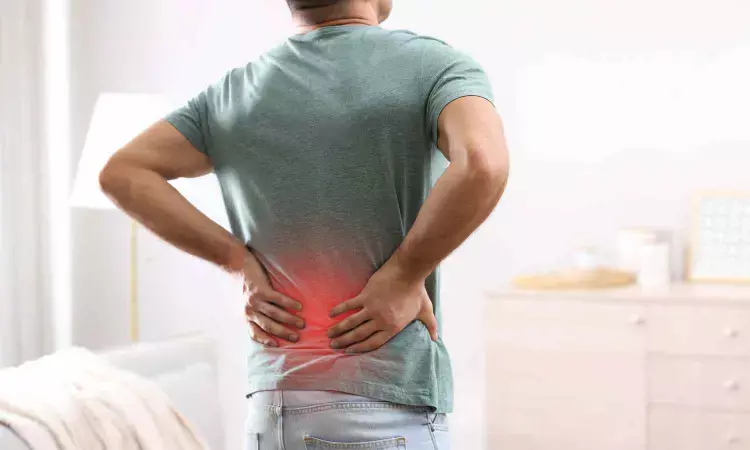- Home
- Medical news & Guidelines
- Anesthesiology
- Cardiology and CTVS
- Critical Care
- Dentistry
- Dermatology
- Diabetes and Endocrinology
- ENT
- Gastroenterology
- Medicine
- Nephrology
- Neurology
- Obstretics-Gynaecology
- Oncology
- Ophthalmology
- Orthopaedics
- Pediatrics-Neonatology
- Psychiatry
- Pulmonology
- Radiology
- Surgery
- Urology
- Laboratory Medicine
- Diet
- Nursing
- Paramedical
- Physiotherapy
- Health news
- Fact Check
- Bone Health Fact Check
- Brain Health Fact Check
- Cancer Related Fact Check
- Child Care Fact Check
- Dental and oral health fact check
- Diabetes and metabolic health fact check
- Diet and Nutrition Fact Check
- Eye and ENT Care Fact Check
- Fitness fact check
- Gut health fact check
- Heart health fact check
- Kidney health fact check
- Medical education fact check
- Men's health fact check
- Respiratory fact check
- Skin and hair care fact check
- Vaccine and Immunization fact check
- Women's health fact check
- AYUSH
- State News
- Andaman and Nicobar Islands
- Andhra Pradesh
- Arunachal Pradesh
- Assam
- Bihar
- Chandigarh
- Chattisgarh
- Dadra and Nagar Haveli
- Daman and Diu
- Delhi
- Goa
- Gujarat
- Haryana
- Himachal Pradesh
- Jammu & Kashmir
- Jharkhand
- Karnataka
- Kerala
- Ladakh
- Lakshadweep
- Madhya Pradesh
- Maharashtra
- Manipur
- Meghalaya
- Mizoram
- Nagaland
- Odisha
- Puducherry
- Punjab
- Rajasthan
- Sikkim
- Tamil Nadu
- Telangana
- Tripura
- Uttar Pradesh
- Uttrakhand
- West Bengal
- Medical Education
- Industry
Study Reveals Increased Stiffness in Deep Lumbar Multifidus Muscle in Athletes with Chronic Low Back Pain

Hong Kong: Research published in the Archives of Physical Medicine and Rehabilitation highlights using shear-wave elastography to measure tissue stiffness in athletes with low-back pain (LBP). The study, led by Siu Ngor Fu, PhD, from the Hong Kong Polytechnic University, found that athletes with low-back pain exhibited increased stiffness in the deep lumbar multifidus (DLM) muscle. At the same time, those involved in sports requiring significant back extension had higher stiffness in the superficial lumbar multifidus (SLM) muscle.
The researchers suggest that rehabilitation for chronic low-back pain should focus on reducing stiffness in the DLM through targeted interventions. Additionally, they recommend sport-specific conditioning programs to address SLM stiffness, which can help prevent injuries and improve athletic performance. The findings underscore the importance of tailoring rehabilitation and conditioning strategies to the specific muscle layer affected by low-back pain and the demands of the sport.
Elevated stiffness in the lumbar multifidus has been noted in individuals with chronic low back pain. However, the differential modulation of stiffness in the deep (DLM) and superficial (SLM) layers of the lumbar multifidus, given their distinct structural roles and functions, has not been fully explored, particularly in athletes. To address this gap, the researchers aimed to compare the stiffness of the DLM and SLM in professional athletes from various sports, both with and without chronic LBP.
For this purpose, the researchers conducted a cross-sectional study at a provincial sports training centre. Ninety-nine professional athletes (aged 18-27 years) from weightlifting, badminton, and track and field teams were recruited, with 38 experiencing chronic bilateral low back pain. Ultrasound shear wave elastography (SWE) was used to measure the Young's modulus (a stiffness indicator) of the deep lumbar multifidus (DLM) and superficial lumbar multifidus (SLM) at the L4/5 facet joint level. A two-way analysis of variance was performed to examine the effects of chronic LBP and sport type on DLM and SLM stiffness while accounting for relevant confounders.
The key findings of the study were as follows:
- Athletes with chronic low back pain exhibited significantly higher deep lumbar multifidus (DLM) stiffness compared to pain-free athletes.
- DLM stiffness was increased by 17.73% on the dominant side (mean difference [MD] = 2.52kPa) and by 13.54% on the non-dominant side (MD = 1.83kPa).
- Superficial lumbar multifidus (SLM) stiffness showed significant variation among the three athlete groups.
- Post-hoc analyses revealed that weightlifters had significantly higher SLM stiffness on the non-dominant side than badminton players (by 51.76%, MD = 8.97kPa) and track and field athletes (by 72.01%, MD = 11.01kPa).
"Chronic low back pain and the type of sport significantly influence multifidus muscle stiffness, highlighting the importance of targeted clinical assessments and reconditioning strategies. These should focus on the deep lumbar multifidus for those with chronic LBP and the superficial lumbar multifidus for athletes engaged in trunk extension-intensive sports," the researchers concluded.
Reference: https://www.archives-pmr.org/article/S0003-9993(24)01353-4/abstract
Dr Kamal Kant Kohli-MBBS, DTCD- a chest specialist with more than 30 years of practice and a flair for writing clinical articles, Dr Kamal Kant Kohli joined Medical Dialogues as a Chief Editor of Medical News. Besides writing articles, as an editor, he proofreads and verifies all the medical content published on Medical Dialogues including those coming from journals, studies,medical conferences,guidelines etc. Email: drkohli@medicaldialogues.in. Contact no. 011-43720751


